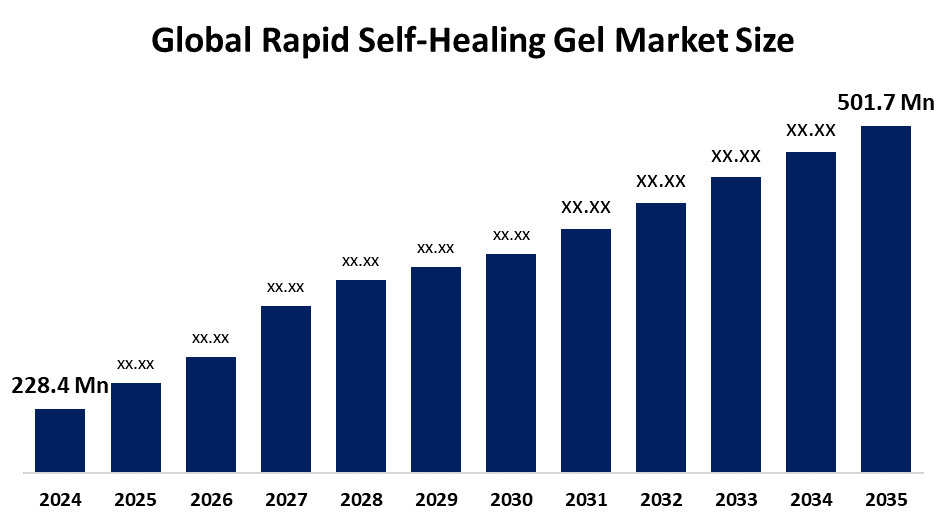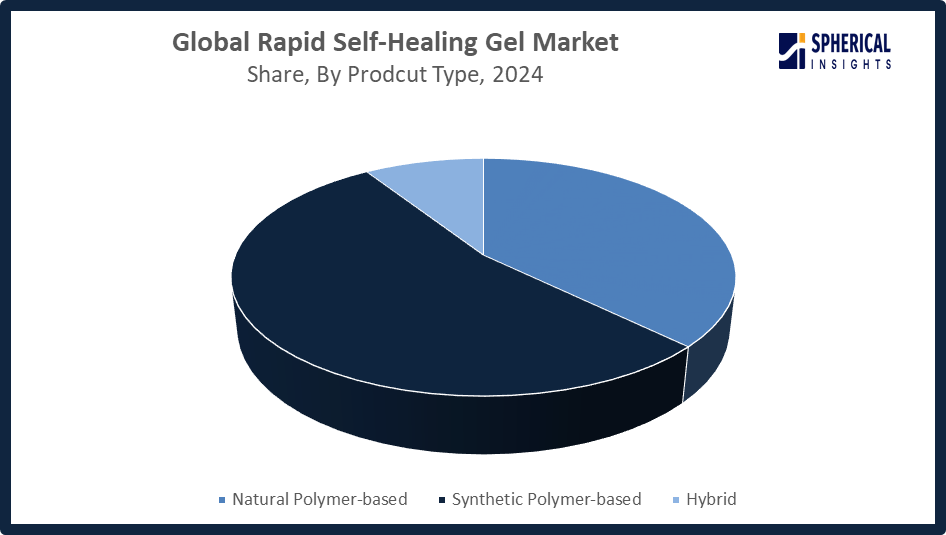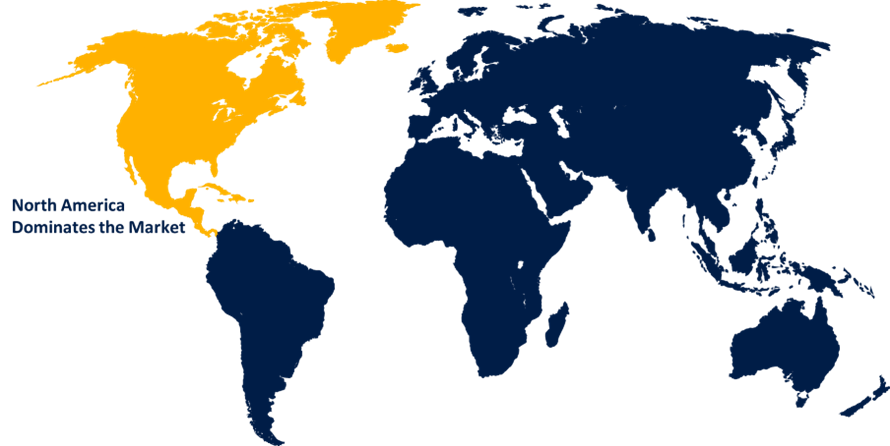Global Rapid Self-Healing Gel Market Size, Share, and COVID-19 Impact Analysis, By Product Type (Natural Polymer-based, Synthetic Polymer-based, and Hybrid), By Application (Biomedical, Electronics, Coatings, Soft Robotics, and Others), By End-User (Healthcare, Electronics, Automotive, Construction, and Others), and By Region (North America, Europe, Asia-Pacific, Latin America, Middle East, and Africa), Analysis and Forecast 2025 - 2035
Industry: Chemicals & MaterialsGlobal Rapid Self-Healing Gel Market Insights Forecasts to 2035
- The Global Rapid Self-Healing Gel Market Size Was Estimated at USD 228.4 Million in 2024
- The Market Size is Expected to Grow at a CAGR of around 7.42% from 2025 to 2035
- The Worldwide Rapid Self-Healing Gel Market Size is Expected to Reach USD 501.7 Million by 2035
- Asia Pacific is expected to grow the fastest during the forecast period.

Get more details on this report -
According to a research report published by Spherical Insights and Consulting, The Global Rapid Self-Healing Gel Market Size was worth around USD 228.4 Million in 2024 and is predicted to grow to around USD 501.7 Million by 2035 with a compound annual growth rate (CAGR) of 7.42% from 2025 to 2035. The rapid self-healing gel market is growing with increased demand for high-performance materials for applications in healthcare for wound healing, drug delivery, and regenerative medicine. This is accompanied by expanding uses in electronics, automotive, and construction, where durability is a vital requirement.
Market Overview
The global rapid self-healing gel market refers to advanced materials that are intended to self-repair structural damage in seconds or minutes once broken. The gels consist of dynamic polymers and smart materials that allow recovery of mechanical properties instantly without any external action. The major applications cover biomedical devices, wound care, drug delivery, soft robotics, electronics, and coatings. In the medical arena, they are highly useful in tissue engineering and wound dressings with self-repairing features due to their high biocompatibility and water retention capacity. The market is experiencing robust growth owing to increasing demand for smart and responsive materials, especially in healthcare and wearable electronics. Growing instances of chronic wounds and the aging population also favor adoption in wound care. Moreover, the increasing focus on longevity and life cycle in electronics and soft robots drives investment and innovation within this space.
The driver is innovation, with developments in supramolecular chemistry, polymer design, and nanotechnology that improve gel performance, recovery rate, and environmental responsiveness. Dominant market players are Axalta Coating Systems, Hydromer Inc., Cardinal Health, and 3M, supplemented by various research institutions and startups innovating in R&D. Growth opportunities exist in increased usage in flexible electronics, regenerative medicine, and green consumer products. The market for rapid self-healing gels is geared for high growth as industries realize the need for intelligent materials that require low maintenance and have long-lasting functionality. In 2024, the USA invested more than US$350 billion in rehabilitation projects for infrastructures incorporating self-healing materials such as coatings, concrete, and gels. Research incentive programs by agencies such as the U.S. Department of Energy support this initiative through encouraging the adoption of advanced materials in public infrastructure.
Report Coverage
This research report categorizes the rapid self-healing gel market based on various segments and regions, forecasts revenue growth, and analyzes trends in each submarket. The report analyses the key growth drivers, opportunities, and challenges influencing the rapid self-healing gel market. Recent market developments and competitive strategies such as expansion, type launch, development, partnership, merger, and acquisition, have been included to draw the competitive landscape in the market. The report strategically identifies and profiles the key market players and analyses their core competencies in each sub-segment of the rapid self-healing gel market.
Global Rapid Self-Healing Gel Market Report Coverage
| Report Coverage | Details |
|---|---|
| Base Year: | 2024 |
| Market Size in 2024: | USD 228.4 Million |
| Forecast Period: | 2025-2035 |
| Forecast Period CAGR 2025-2035 : | 7.42% |
| 2035 Value Projection: | USD 501.7 Million |
| Historical Data for: | 2020-2023 |
| No. of Pages: | 245 |
| Tables, Charts & Figures: | 126 |
| Segments covered: | By Product Type, By Application, By End-User and By Region |
| Companies covered:: | Axelgaard, Cardinal Health, Hydromer Inc, Scapa Group Plc, Advanced Medical Solutions Group Plc, Alliqua Biomedical, Cytogel Pharma, Evonik Industries, Covestro AG, NEI Corporation, BASF SE, Katecho, Inc., R&D Medical Products, Inc., Others, and |
| Pitfalls & Challenges: | Covid 19 Impact Challenges, Future, Growth and Analysis |
Get more details on this report -
Driving Factors
The rapid self-healing gel market is growing due to rising demand for smart, long-lasting materials in healthcare, electronics, and manufacturing industries. Rising prevalence of chronic wounds and requirement for advanced wound care devices drive biomedical applications. Development of wearable electronics and soft robotics stimulates demand for flexible, repairable gels. Environmental sustainability influences products that lead to longer product life and less waste. Advances in polymer chemistry and nanotechnology improve the performance, velocity, and multi-functionality of gels. Moreover, increased investment in infrastructure development and government backing for innovative materials drive market growth globally.
Restraining Factors
The main limiting factors in the case of the global rapid self-healing gel market are high manufacturing costs, complicated manufacturing processes, small-scale commercialization possibilities, tight regulatory approvals, and unawareness at the end-user level. Moreover, issues of ensuring consistency in product performance and scalability limit large-scale use, particularly in developing countries with weak healthcare infrastructure and financial resources.
Market Segmentation
The rapid self-healing gel market share is classified into product type, application, and end-user.
- The synthetic polymer-based segment dominated the market in 2024, approximately 54% and is projected to grow at a substantial CAGR during the forecast period.
Based on the product type, the rapid self-healing gel market is divided into natural polymer-based, synthetic polymer-based, and hybrid. Among these, the synthetic polymer-based segment dominated the market in 2024 and is projected to grow at a substantial CAGR during the forecast period. Synthetic polymer gels, formed by materials such as polyacrylic acid and polydimethylsiloxane, have superior mechanical strength and healing regulation. Utilized in long-lasting applications such as electronics and automotive sectors, their tailored nature pushes mass adoption. Developments targeting green synthetic gels are also creating new business opportunities, increasing demand throughout industries.

Get more details on this report -
- The biomedical segment accounted for the largest share in 2024, approximately 45% and is anticipated to grow at a significant CAGR during the forecast period.
Based on the application, the rapid self-healing gel market is divided into biomedical, electronics, coatings, soft robotics, and others. Among these, the biomedical segment accounted for the largest share in 2024 and is anticipated to grow at a significant CAGR during the forecast period. This segment growth is due to gels imitating natural tissue for drug delivery, wound healing, and tissue engineering. With advancing medicine, these gels are being integrated more into therapies and medical devices to enhance patient outcomes. This increasing use fuels tremendous market growth, underlining the significant function of these self-healing gels in novel healthcare solutions.
- The healthcare segment accounted for the highest market revenue in 2024, approximately 50% and is anticipated to grow at a significant CAGR during the forecast period.
Based on the end user, the rapid self-healing gel market is divided into healthcare, electronics, automotive, construction, and others. Among these, the healthcare segment accounted for the highest market revenue in 2024 and is anticipated to grow at a significant CAGR during the forecast period. The largest consumer of self-healing gels is the healthcare industry, applying their biocompatibility and self-repairing properties to medical treatments. The gels are critical in the production of advanced wound dressings, tissue scaffolds, and drug delivery systems, where self-healing boosts the effectiveness of treatments and patient care, compelling the increasing demand for them in medical uses.
Regional Segment Analysis of the Rapid Self-Healing Gel Market
- North America (U.S., Canada, Mexico)
- Europe (Germany, France, U.K., Italy, Spain, Rest of Europe)
- Asia-Pacific (China, Japan, India, Rest of APAC)
- South America (Brazil and the Rest of South America)
- The Middle East and Africa (UAE, South Africa, Rest of MEA)
North America is anticipated to hold the largest share of the rapid self-healing gel market over the predicted timeframe.

Get more details on this report -
North America is anticipated to hold the largest share of the rapid self-healing gel market over the predicted timeframe. North America is expected to hold the approximate 45% of market share in the rapid self-healing gel market during the forecast period, led mainly by the United States. The U.S. is at the forefront because of the sophisticated healthcare infrastructure, high spending on healthcare, and great focus on R&D and innovation. Major market players and start-ups in the region concentrate on formulating advanced self-healing gel technology for biomedical, electronic, and automotive use. Also, support from the government, supportive regulations, and increased adoption of advanced materials in various industries contribute to market growth in North America as well.
Asia Pacific expected to grow at a rapid CAGR in the rapid self-healing gel market during the forecast period. The Asia Pacific region rapidly growing in the fast self-healing gel market over the forecast period, with approximate market share of 34%, led primarily by China and India. Both nations are witnessing rising investments in healthcare infrastructure, growing rates of chronic diseases, and expanding need for sophisticated wound care solutions. Moreover, growing electronics and automotive sectors in these nations are driving demand for long-lasting, self-healing materials. Supportive government policies and increasing R&D activity further support the region's strong market growth.
Europe's high-pace self-healing gel industry is developing gradually, dominated by Germany, France, and the UK. The industry is boosted by robust healthcare infrastructure, high levels of investments in biomedical science, and rising use of high-performance materials in medical and industrial applications. Support from the government for innovation and sustainability, and growing demand for enhanced wound healing and durability of electronics, are major factors that are driving the region's increasing market size during the forecast period.
Competitive Analysis:
The report offers the appropriate analysis of the key organizations/companies involved within the rapid self-healing gel market, along with a comparative evaluation primarily based on their type of offering, business overviews, geographic presence, enterprise strategies, segment market share, and SWOT analysis. The report also provides an elaborative analysis focusing on the current news and developments of the companies, which includes type development, innovations, joint ventures, partnerships, mergers & acquisitions, strategic alliances, and others. This allows for the evaluation of the overall competition within the market.
List of Key Companies
- Axelgaard
- Cardinal Health
- Hydromer Inc
- Scapa Group Plc
- Advanced Medical Solutions Group Plc
- Alliqua Biomedical
- Cytogel Pharma
- Evonik Industries
- Covestro AG
- NEI Corporation
- BASF SE
- Katecho, Inc.
- R&D Medical Products, Inc.
- Others
Key Target Audience
- Market Players
- Investors
- End-users
- Government Authorities
- Consulting and Research Firm
- Venture capitalists
- Value-Added Resellers (VARs)
Recent Development
- In September 2025, Covestro expanded production of its NIA-PFAS super-durable flexible powder coating polyester (Uralac Premium P 8000 and P 9000) to Asia-Pacific. Produced at its Pingtung Site, the solution meets climate goals and PFAS regulations, enhancing durability for construction, agricultural, and heavy equipment applications.
- In April 2025, BASF expanded its natural-based personal care portfolio with three new sustainable products, Verdessence Maize, a natural styling polymer, Lamesoft OP Plus, a wax-based opacifier, and Dehyton PK45 GA/RA, a betaine sourced from Rainforest Alliance Certified coconut oil.
- In June 2024, Hydromer, Inc. launched HydroThrombX, an advanced thromboresistant coating succeeding its legacy F200t product. Known for reducing platelet adhesion and cell mitosis, this next-generation solution enhances restenosis prevention in medical devices, reinforcing Hydromer’s leadership in hydrophilic and antimicrobial coating technologies.
- In March 2023, NanoTech Labs introduced a groundbreaking self-healing gel with enhanced mechanical strength. This advancement represents a significant leap in self-healing materials, offering improved durability and performance under extreme conditions, and expanding potential applications across various demanding industries.
- In January 2023, AquaGen Solutions partnered with BioTech Innovators to launch a bioactive healing gel. This innovative product blends AquaGen’s water-based technology with BioTech’s bioactive compounds, accelerating healing and minimizing scarring in chronic wounds, marking a significant advancement in advanced wound care solutions.
Market Segment
This study forecasts revenue at global, regional, and country levels from 2020 to 2035. Spherical Insights has segmented the rapid self-healing gel market based on the below-mentioned segments:
Global Rapid Self-Healing Gel Market, By Product Type
- Natural Polymer-based
- Synthetic Polymer-based
- Hybrid
Global Rapid Self-Healing Gel Market, By Application
- Biomedical
- Electronics
- Coatings
- Soft Robotics
- Others
Global Rapid Self-Healing Gel Market, By End-User
- Healthcare
- Electronics
- Automotive
- Construction
- Others
Global Rapid Self-Healing Gel Market, By Regional Analysis
- North America
- US
- Canada
- Mexico
- Europe
- Germany
- UK
- France
- Italy
- Spain
- Russia
- Rest of Europe
- Asia Pacific
- China
- Japan
- India
- South Korea
- Australia
- Rest of Asia Pacific
- South America
- Brazil
- Argentina
- Rest of South America
- Middle East & Africa
- UAE
- Saudi Arabia
- Qatar
- South Africa
- Rest of the Middle East & Africa
Frequently Asked Questions (FAQ)
-
1. What is the CAGR of the rapid self-healing gel market over the forecast period?The global rapid self-healing gel market is projected to expand at a CAGR of 7.42% during the forecast period.
-
2. What is the market size of the rapid self-healing gel market?The global rapid self-healing gel market size is expected to grow from USD 228.4 million in 2024 to USD 501.7 million by 2035, at a CAGR of 7.42% during the forecast period 2025-2035.
-
3. Which region holds the largest share of the rapid self-healing gel market?North America is anticipated to hold the largest share of the rapid self-healing gel market over the predicted timeframe.
-
4. What is the rapid self-healing gel market?The rapid self-healing gel market refers to the growing global market for materials that can automatically repair themselves when damaged, extending product lifespan and increasing durability.
-
5. Who are the top 10 companies operating in the global rapid self-healing gel market?Axelgaard, Cardinal Health, Hydromer Inc, Scapa Group Plc, Advanced Medical Solutions Group Plc, Alliqua Biomedical, Cytogel Pharma, Evonik Industries, Covestro AG, NEI Corporation, BASF SE, Katecho, Inc., R&D Medical Products, Inc., and Others.
-
6. What factors are driving the growth of the rapid self-healing gel market?The growth of the rapid self-healing gel market is driven by the increasing demand for advanced, durable materials in various industries like electronics, healthcare, and automotive. Key factors include a rising prevalence of chronic wounds, technological advancements in gel formulations, and a growing focus on sustainability and eco-friendly solutions.
-
7. What are the market trends in the rapid self-healing gel market?Market trends in the rapid self-healing gel market include a surge in demand driven by advancements in bioengineering and nanotechnology, an expanding application spectrum beyond healthcare into cosmetics and consumer electronics, and a growing emphasis on sustainability and personalized, stimuli-responsive formulations.
-
8. What are the main challenges restricting wider adoption of the rapid self-healing gel market?The wider adoption of the rapid self-healing gel market is primarily restricted by economic, manufacturing, and performance challenges. Regulatory hurdles, material stability issues, and environmental impact also constrain market growth.
Need help to buy this report?